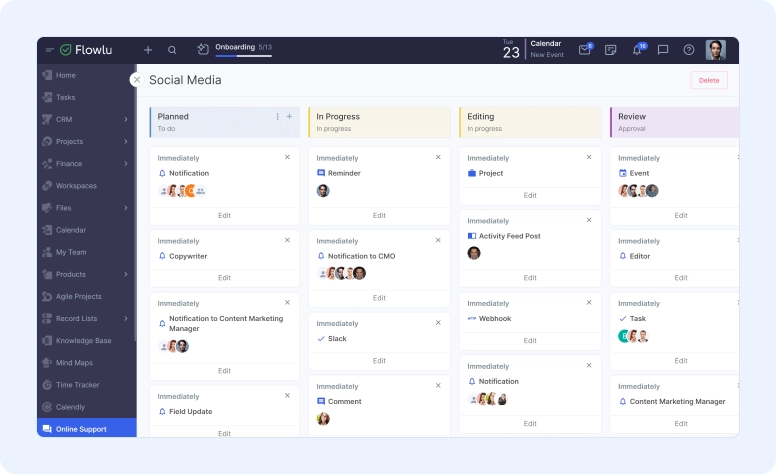What is Automation in Project Management: Best Ideas to Automate Your Projects
3,960
Mon, Mar 18
Projects

Paul Burke
Senior Writer

Originally, project management was invented to facilitate the lives of project managers and the team in general. But, as it often happens, even the best tools or methodologies can sometimes lead to micromanagement and employee burnout.
Endless tasks, managers always walking around asking about task statuses, different workflows for each project, and chat notifications popping up almost every minute. Does that really help boost someone's productivity? We truly believe that it doesn’t work like that.
What if we say that the problem is not yours? You don’t have to think about how to save time on doing your duties to handle administrative to-dos instead. All the task assignments, reporting, notifications, email sending, and a number of other boring activities can be done automatically.
If project management automation still sounds like something magical to you, explore this article to learn how to streamline your repetitive to-dos, get the best benefits from robotization, and learn ideas on how to build a top-notch workflow.
What is Project Management Automation
Simply put, project management automation works exactly as it sounds. With specific software, all project management-related activities can be done automatically. At the beginning, a manager defines the most essential needs of the team. If the team doesn’t use project management software at all, it becomes another step in the process of finding a perfect PM software.
Once the software is found, implemented, and all processes are automated, an organization can run its projects faster with the least impact of a human factor. In addition to simply making your performance better and saving time for employees to focus on more profitable activities, automation has some uneven values:
- Streamlined reporting
- Predefined project cycle
- Overall visibility
- Regular notifications
- Automated emails and comments
In Lua CRM, project management automation covers all essentials, such as team collaboration, project status, event management, task assignment, relations with other entities, and basically any important update or interaction with a project.
Sometimes, PM automation comes together with task management. In Lua CRM, you can simply link task and project workflows together, so no action will stay out of your sight.
Many companies are offering tools for workflow automation, but sometimes they have completely different purposes and give different benefits, and not any software can suit your needs. So how do you understand which benefits you need from a project automation tool?
5 Benefits of Project Management Automation
If something doesn’t profit you, it means that you just don’t need it. So, before starting to pick new automated software and finding the best examples of robotization, let’s quickly outline the benefits of using automation tools.
1. Helps streamline task management
Most apps have very advanced features to manage tasks. You can assign tasks to employees, set deadlines, create relations, add tags or priorities, and so on. All these tools are very handy to build the plan of a project and distribute responsibilities, but they can also ruin all the motivation for employees. You may be wondering how, but it’s a pretty simple answer. When you have a lot of things to do, the last thing you want is to waste time creating new tasks every morning, setting priorities, changing statuses, and checking each previous task manually. Automations can completely liberate you from task administration. Instead of doing regular manual task revision, you can simply set up an automated workflow once and focus on a strategy and more important activities.
2. Ensures seamless collaboration
Working on a project is always a team effort and you can’t stay out of it. But we are absolutely sure that you don’t want to start your day with endless messages in the working chat or texting emails to your clients or colleagues until the afternoon. Automations won’t let you miss any messages and can also streamline your emails. For example, if you need to write a follow-up email to the client by the end of the project, you can do this automatically for all your clients by setting a rule once.
3. Reduces bottlenecks
Bottlenecks are natural, especially when the team manages itself without any automated tools. A senior can just forget to approve or review the task from a junior because he didn’t receive a notification. It’s a very common situation. And if the task is not approved, it stops the whole workflow. Avoiding bottlenecks is quite simple with automations. Each team member will receive a notification if the task needs approval. And if a project reaches a new stage, all new tasks will be created automatically, so teammates don’t have to wait until the manager creates an assignment for team members.
4. Provides better visibility
It’s important to analyze your performance and make reports once the project reaches a milestone. It’s hard to gather the raw data manually each time and process it then. Why would you do that if dashboards and automated reporting already exist? Real-time reporting will not only save you time, but also show you the most up-to-date information about your performance toward the project.
5. Handles integrations with other apps
You probably already have lots of tools or apps that you love to use. They may not cover automation and management, but they're still an important part of your project. For example, many teams prefer to collaborate via Slack. In Lua CRM, you can simply automate Slack messages that need to be sent after your projects reach a certain point. What's more, outgoing webhooks will help you stay notified about all updates made inside Lua CRM in any external app you use.









